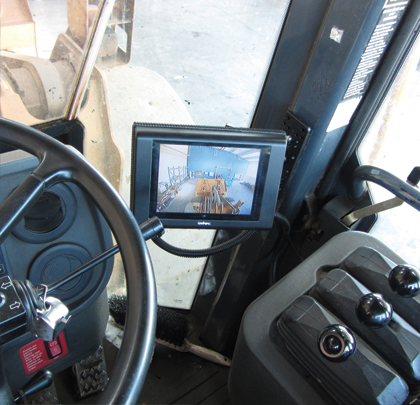Construction sites are usually teeming with a variety of vehicles, equipment, and workers. This means a lot of noise and activity. Over the years, various organizations in partnership with the construction industry have strived to make these sites safer for the workers, as well as the public. One of the targeted safety problems is the frequency of backover incidents and ways to give both the driver and those on the ground more awareness of each other. We have seen the introduction of mirrors, bright safety vests, audible alarms, as well as other technologies. One of the most effective technologies, however, has been the backup camera system.
THE BACKUP CAMERA
Using a backup camera has some very serious benefits that cannot be achieved with other safety technologies and practices. Most obviously, with a camera the vehicle operator can actually see what’s around him, and more specifically, what is directly in his blind spot. This may be somewhat achievable with mirrors, but not nearly as efficient as a camera mounted in way that gives the operator a clear literal view of blind spots. Secondly, as a result of efforts to make construction sites safer, there are quite a few audible alarms being used. For example, when we hear that high pitched beep we tend to think there is a truck backing up somewhere. This is a successful integration of a safety technology; however, it has one pitfall that has become more understood. It would appear that there are so many audible alarms now that they have become integrated into the worker’s expectancy of what they hear while on-site. This means that they no longer react to the beeping warnings because they have become so frequent—the worker has become desensitized to them. With consideration to any ear protection workers may be wearing to combat the noise levels from the machinery and equipment, the effectiveness of alarms becomes even more of a concern. In an article published in the American Industrial Hygiene Association Journal in November/December 2002 by Alice Suter, it is argued that “the audibility of backup alarms on dump trucks is compromised because of the ineffectiveness of their acoustic signals.” From Table IX, “Deadly Accidents Involving Heavy Vehicles and Noise,” underneath this passage in the paper it is clearly stated that reasons for backing fatalities included “noise exceeded alarm,” or “poor visibility, plus backup alarm not detected.” In fact most of the fatalities listed included comments such as these. With a camera system however, this pitfall is erased. Because viewing a screen that displays exactly what is around the vehicle does not compete with the high level of noise, camera systems maximize the ability of the driver to be aware of others on the site.
INCREASED FIELD OF VIEW
Vehicles with camera systems allow the operators to see what they cannot with other safety products and practices. But what about the camera itself? What does the camera need to provide that will make it effective? There are several specifications that should be met in order to be considered an effective blind spot camera system. Two of these are sufficient durability of the camera system and a sufficient field of view.
Debris in the air and on the ground means constant wear and tear on equipment. This is why an effective camera system needs to be built out of strong materials. A flimsy plastic enclosure will not protect the fragile lens from common hazards on a construction site. Camera systems that are built and protected by stainless steel material, however, will do the job. Equally important is the IP rating of the camera enclosure. A camera with an IP rating of IP68, for example, is not only going to be able to withstand water hazards such as rain or high pressure hose water, but is also going to keep out dust and larger particles that may be flying around the area. This is very important in keeping your camera functional and also saving you the pain and money in replacing poorly protected cameras.
The field of view is the most important specification of the camera. Without a sufficient field of view, the camera becomes useless and possibly dangerous. To make sure that a camera has the right amount of viewing area, you should make sure that you are able to see both the back end of the vehicle, as well as a large area to the rear in order to detect any objects or people that are in the path of your moving vehicle. You need time to stop, which means you need to see as far ahead as possible. Cameras that only offer a view of several feet in the direction of a blind spot are not reliable cameras and can cause more damage if the operator is relying on it.
If a camera system can provide a field of view that is wide enough to give the operator sufficient time to avoid a collision and durable enough to survive the conditions of the worksite, then it is an efficient investment in increasing the well being of the workers, as well as the public. It is important to conduct ample research into which camera systems out there offer this. Blind spot camera systems are valuable in both the damage they help avoid, as well as the lifecycle cost as a result of their quality. ■
About The Author:
Intec Video Systems, the originator of commercial vehicle rear vision in the U.S., follows a simple but proven philosophy. Build a quality product and you will get reliable performance that lasts. For more information, contact sales rep John DeFazio at 724.929.5500, email jdefazio@intecvideo.com, or visit www.intecvideo.com.
_________________________________________________________________________
Modern Contractor Solutions, January 2014
Did you enjoy this article?
Subscribe to the FREE Digital Edition of Modern Contractor Solutions magazine.

Navigating the Blind Spot


